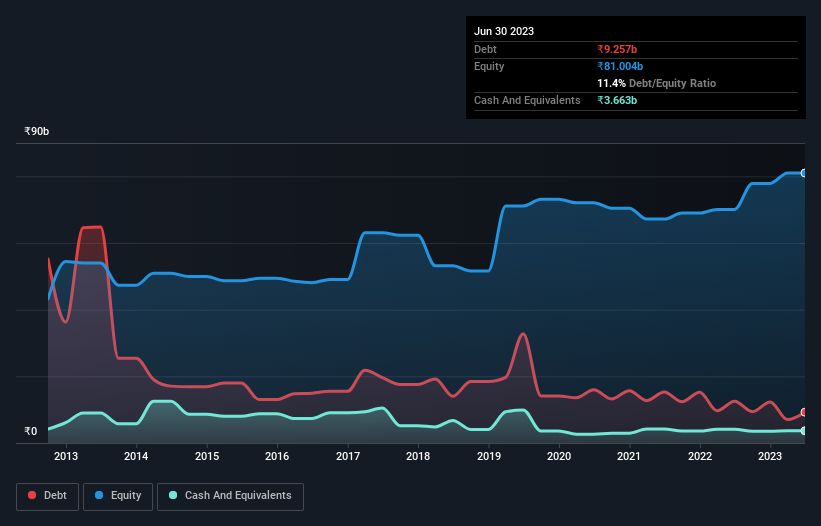- India
- /
- Healthcare Services
- /
- NSEI:FORTIS
Does Fortis Healthcare (NSE:FORTIS) Have A Healthy Balance Sheet?

Warren Buffett famously said, 'Volatility is far from synonymous with risk.' It's only natural to consider a company's balance sheet when you examine how risky it is, since debt is often involved when a business collapses. Importantly, Fortis Healthcare Limited (NSE:FORTIS) does carry debt. But the real question is whether this debt is making the company risky.
When Is Debt Dangerous?
Debt is a tool to help businesses grow, but if a business is incapable of paying off its lenders, then it exists at their mercy. If things get really bad, the lenders can take control of the business. While that is not too common, we often do see indebted companies permanently diluting shareholders because lenders force them to raise capital at a distressed price. Of course, the upside of debt is that it often represents cheap capital, especially when it replaces dilution in a company with the ability to reinvest at high rates of return. When we examine debt levels, we first consider both cash and debt levels, together.
See our latest analysis for Fortis Healthcare
What Is Fortis Healthcare's Net Debt?
As you can see below, Fortis Healthcare had ₹9.26b of debt at March 2023, down from ₹12.5b a year prior. However, it does have ₹3.66b in cash offsetting this, leading to net debt of about ₹5.59b.

A Look At Fortis Healthcare's Liabilities
Zooming in on the latest balance sheet data, we can see that Fortis Healthcare had liabilities of ₹14.3b due within 12 months and liabilities of ₹29.1b due beyond that. Offsetting these obligations, it had cash of ₹3.66b as well as receivables valued at ₹5.86b due within 12 months. So its liabilities total ₹33.8b more than the combination of its cash and short-term receivables.
Given Fortis Healthcare has a market capitalization of ₹257.8b, it's hard to believe these liabilities pose much threat. Having said that, it's clear that we should continue to monitor its balance sheet, lest it change for the worse.
In order to size up a company's debt relative to its earnings, we calculate its net debt divided by its earnings before interest, tax, depreciation, and amortization (EBITDA) and its earnings before interest and tax (EBIT) divided by its interest expense (its interest cover). Thus we consider debt relative to earnings both with and without depreciation and amortization expenses.
Fortis Healthcare has a low net debt to EBITDA ratio of only 0.54. And its EBIT easily covers its interest expense, being 10.4 times the size. So you could argue it is no more threatened by its debt than an elephant is by a mouse. Fortunately, Fortis Healthcare grew its EBIT by 9.0% in the last year, making that debt load look even more manageable. The balance sheet is clearly the area to focus on when you are analysing debt. But it is future earnings, more than anything, that will determine Fortis Healthcare's ability to maintain a healthy balance sheet going forward. So if you want to see what the professionals think, you might find this free report on analyst profit forecasts to be interesting.
Finally, a business needs free cash flow to pay off debt; accounting profits just don't cut it. So we always check how much of that EBIT is translated into free cash flow. During the last three years, Fortis Healthcare produced sturdy free cash flow equating to 66% of its EBIT, about what we'd expect. This cold hard cash means it can reduce its debt when it wants to.
Our View
Happily, Fortis Healthcare's impressive interest cover implies it has the upper hand on its debt. And the good news does not stop there, as its net debt to EBITDA also supports that impression! It's also worth noting that Fortis Healthcare is in the Healthcare industry, which is often considered to be quite defensive. Looking at the bigger picture, we think Fortis Healthcare's use of debt seems quite reasonable and we're not concerned about it. After all, sensible leverage can boost returns on equity. Over time, share prices tend to follow earnings per share, so if you're interested in Fortis Healthcare, you may well want to click here to check an interactive graph of its earnings per share history.
Of course, if you're the type of investor who prefers buying stocks without the burden of debt, then don't hesitate to discover our exclusive list of net cash growth stocks, today.
New: AI Stock Screener & Alerts
Our new AI Stock Screener scans the market every day to uncover opportunities.
• Dividend Powerhouses (3%+ Yield)
• Undervalued Small Caps with Insider Buying
• High growth Tech and AI Companies
Or build your own from over 50 metrics.
Have feedback on this article? Concerned about the content? Get in touch with us directly. Alternatively, email editorial-team (at) simplywallst.com.
This article by Simply Wall St is general in nature. We provide commentary based on historical data and analyst forecasts only using an unbiased methodology and our articles are not intended to be financial advice. It does not constitute a recommendation to buy or sell any stock, and does not take account of your objectives, or your financial situation. We aim to bring you long-term focused analysis driven by fundamental data. Note that our analysis may not factor in the latest price-sensitive company announcements or qualitative material. Simply Wall St has no position in any stocks mentioned.
About NSEI:FORTIS
Fortis Healthcare
An integrated healthcare delivery service provider, offers secondary, tertiary, and quaternary care in India.
Excellent balance sheet with reasonable growth potential.


